ISSN: 1204-5357
ISSN: 1204-5357
| MOHAMED A. ISMAIL Lecturer, Institute of Public Administration, Riyadh, Saudi Arabia Postal Address: Riyadh 11141, Saudi Arabia Author's Personal/Organizational Website: htt://www.ipa.edu.sa Email: ismailm@ipa.edu.sa ; mohamedismail1960@gmail.com Dr. Ismail is a lecturer in Statistics at the Institute of Public Administration. His research areas of interest include efficiency measurement, statistical quality control and research methods. |
| MOHAMMED A. Y. OSMAN Assistant Professor, Institute of Public Administration, Riyadh, Saudi Arabia Postal Address: Riyadh 11141, Saudi Arabia Author's Personal/Organizational Website: htt://www.ipa.edu.sa Email: osmanma@ipa.edu.sa; Mo_yahia@hotmail.com Dr. Osman is an assistant professor of Business Administration at the Institute of Public Administration. His area of interest is marketing of services. |
Visit for more related articles at Journal of Internet Banking and Commerce
This study aims to determine e-banking usage level among retail banking clients' and to identify the factors that influence the adoption of e-banking in Sudan. A self-administered questionnaire was developed and distributed to a sample size of 400 clients using convenience-sampling method. Data analysis was then based on 269 valid responses. The study results indicate that the majority of retail banking industry clients use at least one of the e-banking services. Among all e-banking channels, Automated Teller Machine (ATM) is the most popular channel. The results show that high-income clients and those who have current account and computer and internet literate are more likely to use e-banking services. However, the results show that there are no enough evidence of significant associations between e-banking usage with gender, marital status, education, and occupation. Moreover, the study identified eleven factors that affect the adoption of e-banking in Sudan. These factors include frequent breakdown of ATMs, inconvenient locations of ATMs and Electronic Points of Sale (EPOS), inaccessible internet, lack of means reporting technical problems, unclear legislations protecting e-transactions, slow banks response for correcting erroneous transactions, weak banks' role in raising clients awareness, unclear e-banking guidelines and instructions, frequent power cut offs, and high e-banking services' fees.
Keywords |
| Sudan; E-banking; E-transactions; Retail Banking; ATM; Phone Banking; Mobile Banking; Online Banking; Electronic Points of Sale. |
INTRODUCTION |
| Rapidly growing and changing revolutionized technologies have overwhelmed the world of financial institutions. This form of technological advancement has enhanced delivery of banks’ services, and it has an enormous effect on development of more flexible payments methods and more – user-friendly banking services (Dixit and Datta 2010). Technologies enable both customer and employees to be more effective in getting and providing services. Through self–service technologies customers can serve themselves more effectively (Zeithaml and Bitner, 2003). For instance, via online banking customers can access their accounts, check balances, apply for loan, shift money among accounts, and take care of just about any banking need they might have without the assistance of bank’s employees. |
| Sudatel Telecom Group, the former Sudanese telecommunication corporation, has erected an infrastructure in the field of communication which paved the way for utilizing advanced technologies in the field of e-banking, and government electronic services, consequently, the Electronic Banking Services Company (EBS) was established and formed in 2000 which is geared to facilitate banks with needed equipments, accessories and administer the network that connects all banks. |
| Apparently, the company offers diverse utilities, and working as a consultative figure for the banks, monitoring the network, provision of maintenance, and executing all projects that lead to the development of e- banking activities to sustain excellent services delivery. |
| The above paragraph pervasively constitutes what is meant by e-banking. For many writers and researchers, e-banking is defined within the context of the role it plays as an electronic delivery channel of banking services (Poon, 2008). For the purpose of this research, researchers defined e-banking as all activities that are carried out, processed and delivered through electronic devices in an effort rendering banks services at ease and conveniences. |
| For any business entity, organization, non-for-profit and public sector to attain its objectives it should reserve no efforts but to deliver satisfactory benefits to its clients. Companies nowadays strive to beat competitors by providing and delivering competitive advantages through innovation. Introduction of new products, services, and innovative ideas to target market, should be accompanied by heavy promotional activities to create awareness that inevitably aids the adoption of new product/service. Creating awareness is vital in generating acceptance by customers/ clients. |
| There are several other dimensions needed to be focused on, especially in the field of e-banking such as security, accessibility issues. Researchers are tempted to investigate these issues and other in an effort to identify factors that affect the level of acceptance and adoption of e-banking services in the Sudan. Therefore this study aims to achieve the following objectives: |
| - To determine e-banking usage level among retail banking clients' in Sudan. |
| - To identify the factors that influence the adoption of e-banking in Sudan. |
| - To measure the relationships between demographic variables and e-banking usage. |
LITERATURE REVIEW |
| Nowadays, e-banking is considered to be a vital channel of distributing bank’s services. In many ways, e-banking is like traditional payment, inquiry, and information processing system, differing only in that e-banking utilizes electronic means to deliver these services (Dixit and Datta, 2010). |
| Prior researches have pointed out several factors affecting adoption of e-banking. Poon (2008) has identified ten factors namely, convenience of usage, accessibility, features availability, bank management and image, security, privacy, design, content, speed, and fees and charges. Poon's study revealed that all elements of ten identified factors are significant with respect to the users’ adoption of e-banking services. Privacy and security are the major sources of dissatisfaction, which have influenced users’ adoption. Accessibility, convenience, design and content are sources of satisfaction. Besides, the speed, product features availability, and reasonable service fees and charges, as well as the bank’s operations management factors are critical to the success of e-banks. WAP, GPRS and 3G features from mobile devices are of no significance or influence in the adoption of e-banking services. His study revealed that privacy; security and convenience factors played an important role in determining the users’ acceptance of e-banking services with respect to different segmentation of age group, education level and income level. |
| Dixit and Datta study (2010) spotted many factors like security & privacy, trust, innovativeness, familiarity, awareness level increase the acceptance of e-banking services among Indian customers. Results reveal that adult customers are willing to adopt online banking if banks provide them necessary guidance. They conceded that banks must be concerned with the attitudes of adult customers with regards to acceptance of online banking. Their study also reveals that adult customers are unwilling to uptake technology that might witness or bear risks. Wan, Luck, and Chow (2005) investigated factors that influenced Hong Kong customers’ adoption of four major banking channels, namely, Branch banking, ATM, Telephone banking, and Internet banking. |
| Their study aimed to focus on the influences of demographic variables and psychological beliefs about the positive attributes possessed by the channels. They found that ATM was the most frequently adopted channel, followed by internet banking and branch banking, and telephone banking was the least frequently adopted channel. Psychological beliefs about the extent to which a channel possessed certain positive attributes were more predictive of adoptions of ATM and internet banking than adoptions of branch banking and telephone banking. Demographic backgrounds were strongly associated with the adoption of all banking channels except ATM. |
| Researchers and scholars have pointed out that quality dimensions are important factors affecting customers' satisfaction. Raman, Stephenaus, Alam, and Kuppusamy (2010) tested six e-service quality components that they believed to be of paramount importance in adopting e-banking services in Malaysia. The tested components were ease of use, appearance, reliability, customization, communication, and incentive. Their objectives were to evaluate consumer perceptions on quality of services and internet banking adoption in Malaysia. Results reveal that internet users and non users have different expectation towards e-service quality preferences. |
| Devi and Malarvizhi (2010) investigated customers’ perception of e-banking in India. They found that customers are satisfied with the quality of e-banking services. Their studies showed that ATM is more popular and most cost effective. Their findings reveal that customers were experiencing technical problems and formalities and less social relation with banks. Results witnessed insufficient number of ATM centres. Aslam, Khan, and Tanveer (2011) conducted a research in non-metropolitan area of Pakistan to explore the perceived barriers in adoption of internet banking. Their study reveal that customers were more concerned of forming relationship with bank’s service providers and internet banking perceived to be a possible cause for losing such opportunities. |
| Findings reveal that customers perceived more value in conventional banking system as compared to internet banking. The study also reveals that lack of knowledge and information are perceived to be the most significant barriers in adoption of internet banking. |
E-BANKING IN SUDAN |
| Over the past decade, the number banks in the Sudan has been steadily increasing; the number increased from 27 in 2002 to 32 banks in 2012 (http://www.cbos.gov.sd).Currently the Central Bank of Sudan (CBS) oversees 32 licensed banks of which 27 are registered as commercial, including one state-owned bank, three branches of foreign banks, and 23 joint-venture banks (Table 1). Five banks are registered as "specialized" of which three state-owned banks and two joint-venture banks. |
| The specialized banks provide funds to specific sectors of the economy; agriculture, industry, and social development. All the banks in Sudan are head quartered in Khartoum, the capital city. |
 |
| The Sudanese banking industry as a whole has a network of 506 branches, which is quite low compared to the area of the country (1.9 million square km) and the size of population which is estimated to be 35million in 2012. In addition, the geographical distribution of banks' branches is uneven across the 17 country's states with 190 branches located in Khartoum state, representing 37.5% of total branches (Fig. 1). The bank usage in Sudan is quite low, with 144 banks accounts per thousand adults in 2009 compared with a much higher average of 240 accounts per thousand adults in Africa (The World Bank, 2009). This reveals that cash is still the most dominant medium of exchange. |
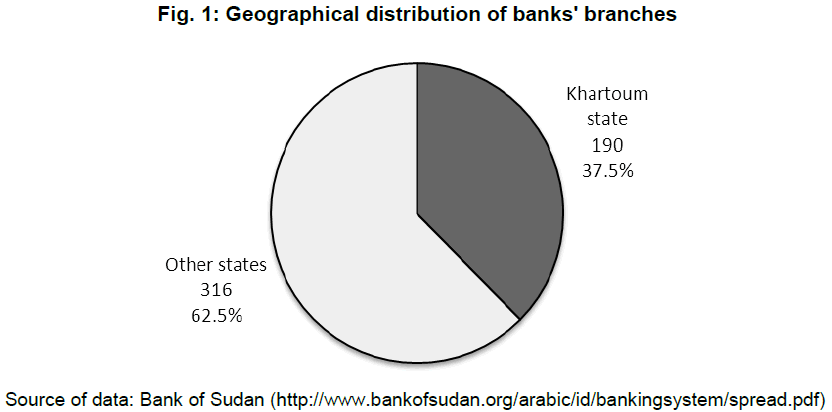 |
| The electronic banking in the Sudan goes back to 1999 when the Central Bank of Sudan (CBS) took the initiative to introduce modern information technologies in Sudanese banking industry as a part of its banking system development plan for 1999-2000. Consequently, the CBS established the Electronic Banking Services Company (EBS) in 1999 to be responsible for building and developing e-banking industry in Sudan(Mahdi, 2007). EBS is a private company owned by CBS (49%), Sudatel Telecom Group (30%) and the Sudanese banks (21%)(Hussein, Albadri, and Abdullah, 2004). It started its operations in 2000 and is dedicated towards introducing banking technologies and solutions, and most importantly payment systems (EBS, 2005). |
| EBS is in charge of the following six major systems hosted at or delegated by CBS (Horus Development Finance, 2011; www.ebs-sd.com): - SWIFT - a shared worldwide data processing and communications link and a common language for international financial transactions came to Sudan in 2000, |
| - National Switch is established in 2006 to provide Automatic Teller Machine (ATM) services, Electronic Point of Sale (EPOS) service, Electronic Funds Transfer (EFT) and allows Sudanese banks communication, |
| - Electronic Cheque Clearance (ECC) - an electronic image-based check clearing solution, designed to provide end-to-end nationwide clearing of cheques within the same day, that was established in Sudan in 2007, |
| - Real Time Gross Settlement (RTGS) - is a funds transfer mechanism where transfer of money takes place from one bank to another on a “real time” and on “gross” basis. This is the fastest possible money transfer system through the banking channel, |
| - Electronic Link system, the core banking system of CBS, and |
| - Electronic Reports system for CBS and commercial banks. |
| At present the Sudanese banks offer e-banking services to their clients through ATM, phone, mobile, internet, and EPOS. ATM services include cash withdrawal, balance inquiry, mini account statement, pin change, transfer money between accounts, bills payment, buying prepaid mobile and electricity recharge cards, and cash deposit which is offered presently by Fiasal Islamic bank only. The most common services of phone and mobile banking are balance inquiry, bills payment, money transfer from one account to another, mini account statement, and sending instant updates on client's account. Internet banking allows a wide range of banking transactions via the bank's website including most services offered via ATM, phone and mobile channels except with cash withdrawal and deposit. Special e-payment services such as e-registration of university students and e-payments of customs fees are currently provided by Fiasal Islamic bank only. EPOS is an electronic payment system that enables clients to pay for their purchases using their ATM cards. The system transfers the ATM card holder's purchases amount from his/her account to the shopping store's account. There were 1563 operating EPOS points in 2009 offered by 19 banks (EBS, 2009). Moreover, most of EPOS are located in Khartoum state. All EPOS are directly connected to the platform operated and hosted by EBS. |
| E-banking was first introduced by Omdurman National bank in 2003 by installing the first ATM in the Sudan (www.onb.com.sd). Thereafter, the numbers of ATMs have been steadily increasing. At present all Sudanese banks have ATMs except two banks. |
| Table 2 shows that the entire Sudanese banking sector has 745 ATMs in 2011 compared to 107 ATMs in 2006, representing 47.4% annual growth rate. The number of ATMs cards issued by Sudanese has increased from 55848 cards in 2006 to 1.9 million cards in 2011, an increase of 3339.9% and annual growth rate of 102.9%. The sharp increase of ATM cards issued in 2011 was due to banks' marketing campaign to increase using ATMs by offering opening free new bank accounts with free ATM cards and with no deposit required. The number of operations made through ATMs amounted to 25.7 million transactions in 2011, recording an increase of 25.2 million transactions in 2006 representing an annual growth rate of 123.4%. |
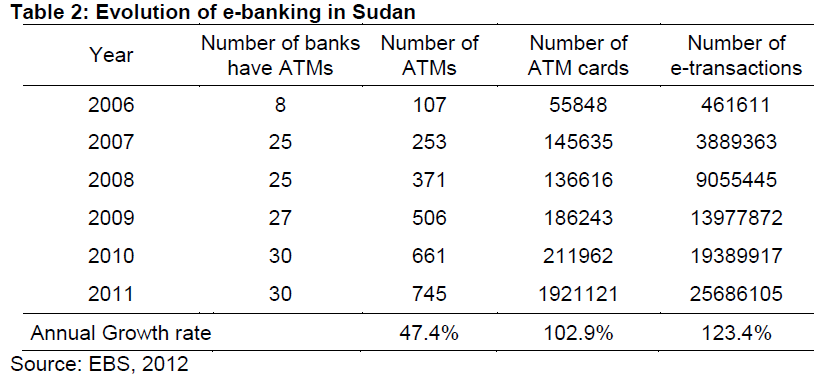 |
RESEARCH METHODOLOGY |
Population and Sample |
| The study population comprised all the banks' clients in Khartoum state who each one had at least one bank account at the time of the survey. A convenience sampling method was used to select the respondents. This method was chosen because it was difficult to obtain a sampling frame for retail banking clients. In addition, convenience sampling provides easy access to the respondents, practical, and quick (Nachmias and Nachmias, 2008). The survey was carried during June-August, 2012. The questionnaires were distributed to a sample of 400 clients while they were in the bank branches at several locations in Khartoum. Of the 400 questionnaires distributed, 269 were returned, giving a response rate of 67.3%. |
Questionnaire development |
| A self-administered questionnaire was developed based on the existing related literature. In tune with prior studies, the questionnaire comprised 19 statements measuring factors affecting the adoption of e-banking in Sudan to be responded on a five-point Likert-scale (1=strongly disagree, 2=disagree, 3=neither agree nor disagree, 4=Agree, 5=strongly agree). In addition, the questionnaire included questions on e-banking usage, computer and internet literacy and six demographic variables. Two experts reviewed the initial version of the questionnaire, one from the banking sector and the other from EBS Company. On the basis of feedback from the reviewers, the questionnaire was amended. To further improve the questionnaire in terms of questions wording, sequence, layout, familiarity with respondents, etc., a pilot study was carried out in January, 2012.The Cronbach's alpha value for the items developed to measure the factors that affect the adoption of e-banking was 0.88; meeting the recommended alpha threshold values of at least 0.7 (Vellis, 2003; Nunanally, 1978). |
Statistical analysis |
| Chi-square test was used to describe and analyze the association between e-banking usage and the demographic variables. Arithmetic mean and standard deviation were used to analyze the respondents' perceptions on items measuring factors affecting adoption of e-banking. In addition, one-sample t-test was conducted to determine whether the mean score of each item is significantly higher than a score 3; this being the mid-point on the likert scale for "Neither agree nor disagree" response to the item. A significant t-test value (p-value 0.05≤) for any item indicates that the respondents agreed the factor affect the adoption of e-banking. |
RESULTS AND DISCUSSION |
Demographic profile |
| The sample consisted of 226 e-banking service users (84%) and 46 non-users (14%). Table 3 presents the demographic characteristics of the respondents with respect to e-banking usage; users and non-users. |
| The results show that majority of respondents were males (72.9%). Most respondents were married, representing 58.7%. Respondents’ levels of education varied relatively with the majority of respondents were university graduates; 81% of the sample had university or post-graduate degrees. With respect to occupation, more than half respondents (52.8%) were professional employees. 62.3% of the respondents had monthly income less than 2500 Sudanese pounds which is equivalent to about 420 US Dollar. Almost all the respondents had either current or saving accounts, representing 48.1% and 41.5% respectively. |
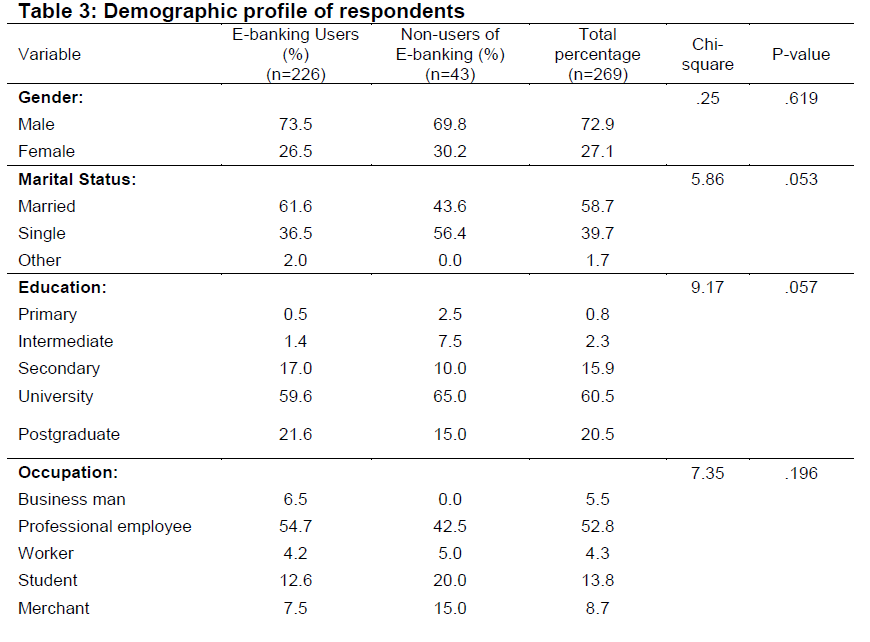 |
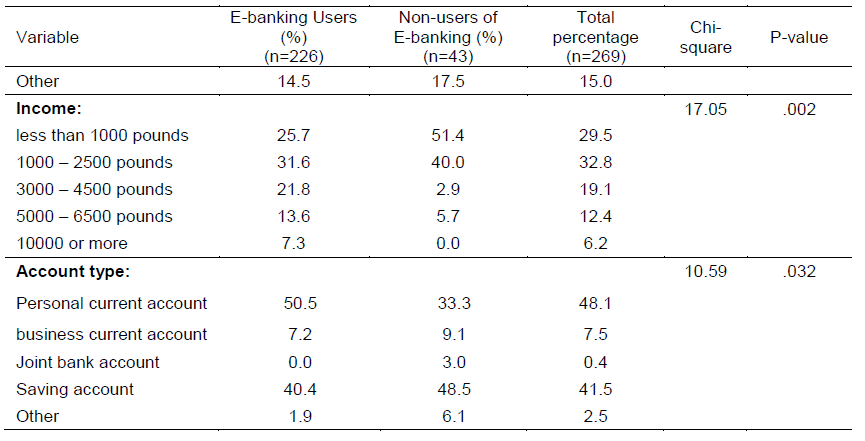 |
| Chi-square test was carried out to measure the association of e-banking usage with each of the six demographic variables. The results are presented in the last two columns of Table 3. |
| The results show that there are no significant associations between e-banking usage with gender, marital status, education, and occupation at 5% level; the respective Chi-square p-values are strictly greater than 0.05(p-value 0.05>). These findings agree with some previous research results such as Tingari and Abdelrahman (2012), Poon (2008) and Nasri (2011). However, these results are inconsistent with other studies which found that there were significant relationships between adoption of e-banking with these four variables (Sohailand Shanmugham, 2004; Mattila, Karjaluoto, Pento, 2003; Singhand Grover,2011; Karjaluoto, 2002, Wu, 2005). |
| On the other hand, the results show that income and account type have significant associations with e-banking adoption at 5% level of significance; the respective p-values are less than 5% (p-value 0.05≤). The frequency distribution shows that 52.7% of e-banking users have more than 3000 Sudanese pounds compared to 8.6% for non-users. This reveals that high-income clients use e-banking more frequently than low-income clients. |
| This result is consistent with the results of researches done by Karjaluoto (2002), Lafore and Li (2005), Yuan, Lee and Kim (2010), and Wu, 2005. However, the result contradicts with Tingari and Abdelrahman (2012) who found that demographic variables including income do not affect the Sudanese bank's clients intention to use banking technology. |
| As for account type, about half of e-banking users have current accounts compared to a third of non-users who have current account. This shows that clients who have current accounts are more likely to adopt e-banking. Interestingly, no previous research studied the relationship between adoption of e-banking and type of bank's account. |
Computer and Internet Literacy |
| Table 4 presents the respondents' levels of computer and internet Literacy. The results show that about three quarters of the respondents (73.8%) had either intermediate or advanced computer levels. The Chi-square test confirmed there were significant association between e-banking usage and computer literacy at 5% level of significance. As can be seen from the table, 80.5% of e-banking users had either intermediate or advanced computer levels compared to 45.2% of non-users of e-banking who had the same computer levels. These results indicate that computer literacy has positive effect on adoption of e-banking. |
| With regards to internet literacy, about three quarters of the respondents stated that they had either intermediate or advanced level of internet use. The chi-square test result shows that there is a significant association between e-banking usage and internet literacy at 5% level. The e-banking users had higher internet usage level compared to non-users. |
| These findings conform with the previous studies which showed that banks' clients with good computer and internet backgrounds are more likely to use e-banking (Poon, 2008; Gerrard and Cunningham, 2003;Howcroft, Hamilton and Hewer, 2002). |
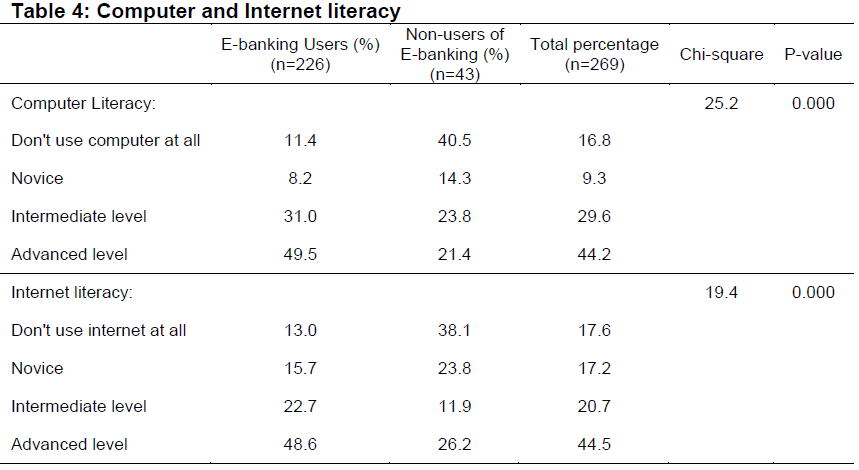 |
Respondents' e-banking usage |
| Respondents were asked to indicate the e-banking channels which they use at the survey time. Table 4 presents the frequency distribution of e-banking usage. Fig. 2 shows the percent distribution of e-banking channels used by the respondents. Among all e-banking channels, ATM has the highest level of usage with 84% of banks' clients use it. Phone banking ranks number two in e-banking usage, representing 18.6% of the sample. Mobile banking is used by 12.6% of the respondents. EPOS is used by about 9% of the respondents. Online banking system was observed to be the least used e-channel with only 6% of clients use online banking. |
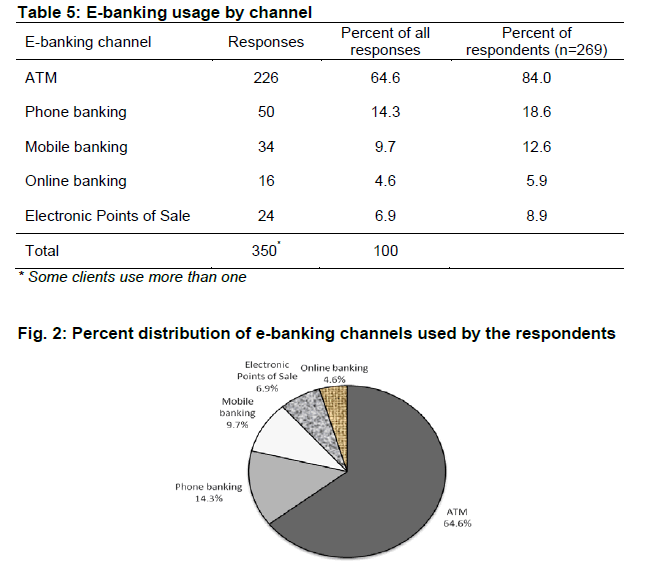 |
Perceptions of banks' clients towards factors affecting adoption of e-banking in Sudan |
| Table 6 presents the results of arithmetic mean, standard deviation, and one-sample t-test for each item developed to measure a factor that affect the adoption of e-banking. Figure 3 depicts the average scores of respondents on the items measuring the factors that affect e-banking adoption with respect e-banking usage; users, non-users, and all respondents. The higher mean of each item indicates higher level of agreement with the item that affect the adoption of e-banking. Furthermore, significant value of one-sample t-test (p-value0.05≤) for any item indicates that the respondents agreed the factor affect the adoption of e-banking. |
| The results show that the mean scores of the respondents' responses for the items measuring these factors ranged between 2.1 to 3.8. This wide range reveals that the respondents were split over the factors affecting adoption of e-banking. The results of the t-test show that the respondents agreed with eleven factors that affect e-banking adoption; the items with average score mean less than or equal 3.0 and p-values less than or equal 0.05. |
 |
| These results concur partially with the findings of Alam, Magboul, and Raman (2010) who found that clients' unawareness and inaccessibility of internet, absence of legislations protecting e-transactions, and poor infrastructure are among the challenges facing Sudanese Banks in implementing online banking. |
| These findings also conform to Mahdi and Dawson (2006) who attributed the slow diffusion of e-banking in Sudan to poor infrastructure including unavailability of highly sophisticated telecommunications system in the country. These findings are also similar to those found in other developing countries like Ethopia (Worku, 2010), Libya (Abukhzam and Lee, 2010), Pakistan (Omar et al, 2011), Nigeria (Auta2010) and India (Karimzadeh and Alam, 2012). |
| The results of the t-test show also that the following do not represent factors affecting adoption of e-banking (items with average score less than or equal 3.0 and p-values greater than 0.05): |
 |
| Despite the above results, Figure 3 shows that most non-user of e-banking respondents see that unawareness of e-banking products, services and lack of computer skills, no advantages for e-transactions over traditional transactions and lack of privacy and confidentiality as factors that would affect the adoption of e-banking. This is indicated by the relatively higher average scores of non-user respondents on these factors compared with users' average scores. |
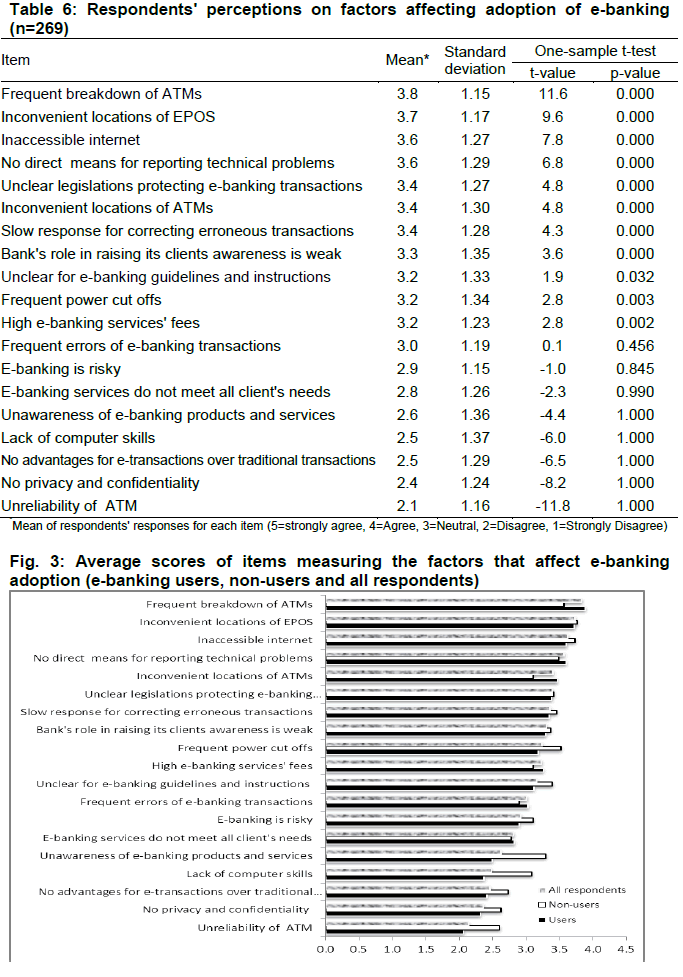 |
CONCLUSION AND RECOMMENDATIONS |
| The study results show that 84% of the retail banking industry clients use at least one of the e-banking services. Among all e-banking channels, ATM has the highest usage level with 84% retail banking clients use it, followed by phone banking with 18.6% usage level, mobile banking which is used by 12.6% of the clients, EPOS is used by about 9% of the clients, and finally online banking system was observed to be the least used e-channel with only 6% of clients use it. The results show e-banking usage is associated with client's income, account type, and computer and internet literacy. High income clients and those who have current account and computer and internet literate are more likely to use e-banking services. However, the results show that there are no enough evidence of significant relationships between e-banking usage with gender, marital status, education, and occupation. Moreover, the study identified eleven factors that affect the adoption of e-banking. These factors include frequent breakdown of ATMs, inconvenient locations of EPS, inaccessible internet, lack of means reporting technical problems, unclear legislations protecting e-transactions, inconvenient locations of ATMs, slow response for correcting erroneous transactions, weak banks' role in raising clients awareness, unclear for e-banking guidelines and instructions, frequent power cut offs, and high e-banking services' fees. |
| Based on aforementioned findings, the Sudanese banks could enhance the promotion of banking services by implementing awareness programs to their current and potential clients on the benefits and using e-banking. To boost e-banking usage, there is a also need to increase the number of ATMs and EPOS with equal distribution within and between Sudan states to make them more accessible to clients. |
| Moreover, as the e-banking services are still limited, there is a need to launch more e-channels such as online payments of utility bills, credit cards, E-mail/SMS alerts for e-transactions, etc. Banks have to set customer problems management system to resolve the issues regarding erroneous transactions. The available infrastructure in Sudan is not sufficient to fulfill the requirements of e-banking technology in all parts of the country. Therefore, the government has a major role to play in promoting the basic infrastructure required to increase the diffusion of e-banking. This includes provision of stable supply of electricity and latest information and communication technologies. Moreover, there is need to enact legislation to protect e-transactions. |
ACKNOWLEDGMENTS |
| The authors would like to express their gratitude to Mr. Malik Kisha for his assistance in data collection. |
References |
|
Copyright © 2025 Research and Reviews, All Rights Reserved